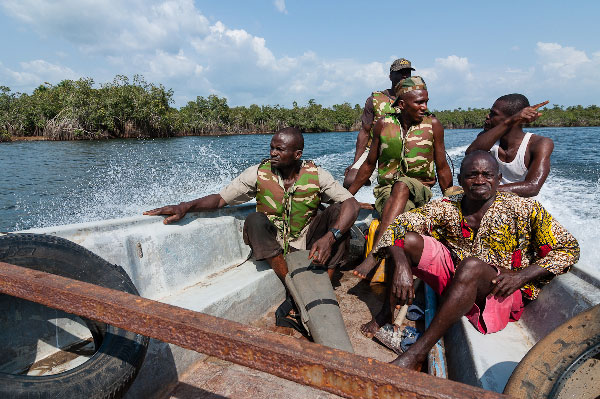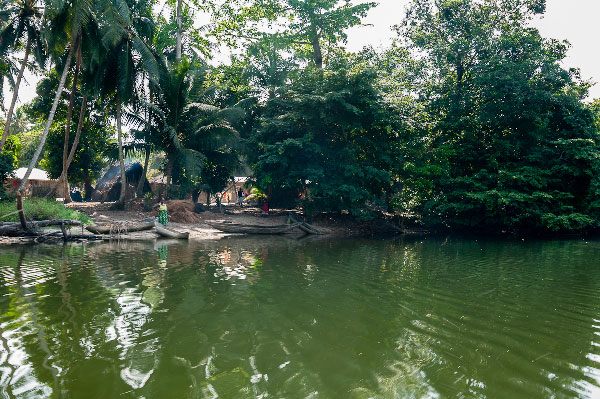Cuba/Africa: An Old Slave Trading Place

Text and Photos by Sergio Leyva Seiglie
HAVANA TIMES — During the filming of ‘They Are We’ —a documentary about the return of four Afro-Cubans to their place of origin in Sierra Leone— along with several of the crew, I travelled down to the remote Gallinas region in the far southeast of Sierra Leone, the place where the Cuban’s ancestor and the famous Amistad slaves once departed from Africa.
Standing in this inaccessible spot on a sandbar looking out into the Atlantic Ocean, I realized that I was possibly the first Cuban to be there in about 150 years.
The Amistad captives—who later rebelled and took their ship to the USA, leading to a celebrated court case—were sold by slave trader Pedro Blanco who once had a mighty empire at the mouth of the Kerefe River in the Gallinas region.
A large part of its attraction then to slave dealers was that it was completely cut off. Today it still is, now long divorced from its ugly slave dealing past.
The only way now to the mouth of the Kerefe is via an extremely bumpy, unpaved road down to Sulima, close to the border with Liberia. There, in the wake of the civil war of the 1990s, Sierra Leone keeps a small naval base.
Lieutenant David Caulker, currently in charge, agrees that the crew can venture out to the Kerefe in one of the navy’s small boats if they pay for the fuel.

The journey through the mangrove-fringed channels is tranquil and beautiful, hardly changed from years gone by. Families in dugout canoes wave as they go fishing.
Soon the water becomes so shallow that everybody has to disembark so that the navy guys can heft the boat over into the Kerefe, which only becomes one continuous waterway with the mangrove creek at high tide.
It is easy to see why this was a prime spot for slave trading. The Atlantic Ocean is only meters away but seems incredibly remote, as its furious waves crash onto the sea bar. Behind the bar the mangrove creeks are utterly calm.
It was easy, one hundred and fifty years ago, for slavers to bring slaves down to the coast on small canoes. The big naval vessels, out patrolling for illegal slave ships, could not get over the bar to capture them. This was how the ancestor of the Afro-Cubans left from this continent.
Huge profits were made here from this deadly traffic. Pedro Blanco, the merchant who sold the Amistad men and women, was said to have left after “fifteen unbroken years…laden with gold.” In mythology, his fortune was said to be “near a million.”
In the 1840s the British made repeated attempts to end the slave traffic here, several times launching naval attacks that burned down the “factories” (where the slaves were housed before being sold abroad). When the slave trade finally came to an end, this place was left abandoned, with little economy beyond fishing.
Today it seems cut off from the rest of the nation. Where Sierra Leone traditionally has round homes made of mud bricks, the villagers here on the sand bar make their homes with sloping raffia roofs on top of rectangular walls, in the shape of an old-fashioned two-man tent.
Another raffia frame supports fish drying in the sun, which after a week or so has the smoky, tangy taste common to local delicacies like plassas and kran kran.

The sad history of this place is all but forgotten. We ask the local chief if he knows any of the past, any local collective memory about Blanco’s vast enterprise, which once had slave quarters on one island, a home on another and his harem on another. But the chief knows nothing. It has all disappeared beneath the more recent tragedies of civil war, poverty and hunger.
Yet the history is still all around. The most noticeable thing is the fact that nothing much has changed here. The factory of Blanco has gone, and the people now have cheap cell phones and occasionally cast-off Western t-shirts, but apart from that life here is as it was 160 years ago.
The transatlantic slave trade changed so much of the world but when it disappeared it left Africa so decimate it was unable to move on. Their labor forces —like Josefa, the ancestor of the Afro-Cubans who made their return— were taken as slaves to build other country’s economies.
I leave Gallinas with a bittersweet sensation; it’s a beautiful place to photograph and it was quite an adventure getting here, but you can’t help but ponder on the region’s and consequently of the whole continent’s history and fate.
So many souls taken on a horrible journey across the ocean and — if they survived— forced into a new life of atrocious enslavement. I can’t help but feel a lingering sense of guilt.
—–
See this related post: Cubans Visit their Ancestral Home in Africa
Click on the thumbnails below to view all the photos in this gallery. On your PC or laptop, you can use the directional arrows on the keyboard to move within the gallery. On cell phones use the keys on the screen.












A well written aperçu on the place of departure of so many terrified souls for the financial glory of many rich families of today.Glad the diabolic stench doesn’t seem to pervade the site today. The terrors perpetrated by the oligarchs have moved to new shores, like Bengladesh.